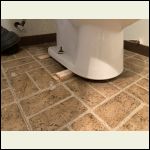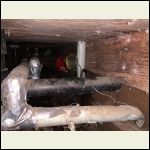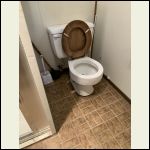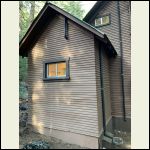| . 1 . 2 . >> |
| Author |
Message |
troodon
Member
|
# Posted: 10 Apr 2022 01:32pm - Edited by: troodon
Reply
Hello, this is my first post here. The context is an older cabin (1930's), unused for 10 or 15 years, which we just bought. The bathroom addition was added later. The foundation of the main structure is post and beam -- old-style log posts resting on rocks. I'm not sure about the bathroom addition portion.
My question: what can be the possible causes for a toilet to end up being too high? The former owner of the cabin recently shimmed it, as shown in two of the pictures. The possible causes I've come up with all have to do with the structure around or under the toilet sinking (my assumption), as opposed to the flange or drain pipe rising (don't know if this ever happens!). Here are the causes I've come up with:
1) The bathroom floor is sagging due to water damage and/or carpenter ants, in which case it would need to be patched or replaced entirely.
2) The joists under the floor are rotted or damaged, due to water and/or carpenter ants, in which case joists would need to be sistered and probably a new floor put in.
3) The whole foundation of the addition is sinking, in which case it would need to be jacked and reinforced, leveled, or whatever.
As you can see in the inside photos, there's no noticeable gap between the floor and the wall, as is sometimes seen. Not sure if that means anything. There has definitely been water damage to that portion of the cabin. The roof above was leaking so badly, the globe light fixture in the ceiling of the bathroom was recently found filled with water. All it needed was a goldfish.
There's only 12 inches or so of space under the floor, plus pipes and drains, so any work will happen from inside the bathroom, looking down. The last picture shows the space underneath the toilet (the coffee can was an emergency measure to prevent a leak from continuing to wet the floor from underneath).
I will be going up there next week for a few days to work on the cabin, so I'm trying to educate myself on how to determine the likeliest cause of the sinking floor and/or rising toilet. I'm prepared to remove flooring and cut through the floor, if necessary for investigation purposes, as we're getting the place re-floored anyway. I can also remove the skirting around 2 of the 3 exterior walls.
I'm not asking for an assessment of what's wrong with the floor, to be clear. I'm trying to make a list of possible or probable causes, and the tell-tale signs, if any, that might differentiate one cause from the other, so that hopefully I can narrow it down and research how to address the problem. I want to know what to look for and inspect when I go up there in a few days. Thanks for reading!
Shimmed Toilet Close-Up
| 
Underneat Toilet
|  |  |
|
|
troodon
Member
|
# Posted: 10 Apr 2022 01:37pm
Reply
I re-uploaded two of the photos, whose rotation was screwed up.
Toilet and Bathroom
| 
Bathroom Addition from Outside
|  |  |
|
|
ICC
Member
|
# Posted: 10 Apr 2022 02:46pm - Edited by: ICC
Reply
Maybe the previous owner/builder just screwed up and made the pipe too tall? DIY sometimes do some nutty things. More duct tape used there than in the average drain/waste piping. 
I can't see any obvious floor sagging on small images on my phone.
|
|
troodon
Member
|
# Posted: 10 Apr 2022 03:06pm
Reply
That's a definite possibility. There are head-scratchers elsewhere in the cabin, distributed across all the various sub-disciplines of homebuilding!
I guess I'll need to be able to assess if 1) the floor's OK, 2) the joists are OK, and 3) the foundation is OK (hasn't sunk). The floor itself doesn't feel spongy when you walk on it, after all.
I have a level, about a yard long, but that's it. I wish I had one of those 360-degree lasers. I was thinking of taking some marble-sized bearings and rolling them around the floor.
|
|
ICC
Member
|
# Posted: 10 Apr 2022 04:04pm - Edited by: ICC
Reply
No obvious dips in what the images show me. Exterior of addition seems to line up with main structure. ??? Where does the drain pipe go? Straight down and then...?? The underside of what can be seen of floor and joist seem okay; level, no sag or broken pieces. Most people caulk the bottom where the toilet sits on the floor. I don't see any traces.
A puzzle why it would be the way it is.
Laying the 3 ft level across the floor should be enough to reveal sags. Use a short length of straight 2x or a length of pipe to extend the reach.
|
|
kevlar
Member
|
# Posted: 10 Apr 2022 05:59pm
Reply
Would it be possible that the previous owner raised it up like that with the intention of laying some new flooring down with subfloor but just never got back to doing it? Like most of my projects.
|
|
troodon
Member
|
# Posted: 10 Apr 2022 06:07pm
Reply
Thanks so much, ICC. I'll wrangle up something to extend the level's reach. Your assessment is comforting, though I realize that's premature.
The toilet drain pipe goes down, but I'm not sure where. The main line into which all the drains in the main structure lead exits the house about ten feet away (slightly downhill from the addition), and I don't see any point in the crawlspace where the drain from the bathroom addition connects to that main pipe going to the septic. I guess they must meet underground just outside the house, downhill from the addition's clean-out. I assume the location of the clean-out means that the toilet's drain runs directly under it, towards the main drain pipe.
Your questions sent me poring over my pictures in detail yet again, and some of the above information I gleaned from them over the last 90 minutes. So thanks again for helping me understand it a bit better.
|
|
troodon
Member
|
# Posted: 10 Apr 2022 06:28pm
Reply
I just asked him, Kevlar. He says no. He's in his 90's, clear as a bell, but never used the cabin much in the first place. There's not much info on the floor, either, so I have to do my own investigation.
|
|
|
troodon
Member
|
# Posted: 10 Apr 2022 08:05pm
Reply
He also says the floor and toilet were level, as far as he can remember, the last time they used the cabin. That was in 2008. He doesn't remember the toilet ever wobbling.
|
|
Brettny
Member
|
# Posted: 11 Apr 2022 06:44am
Reply
Is the floor level now? Could it be that the pipe wasn't draining so he raised the toilet?
It's hard to see the integrity of wood from the pics and if your there taking pics bring a hammer and give a few things a wack..and while your there bring a level too.
|
|
zorro
Member
|
# Posted: 11 Apr 2022 09:20am
Reply
Something very similar has happened at my friends cabin the last 2 years and we are going in 2 weeks to fix it once and for all
The issue is the down pipe of the toilet going into the ground is getting impacted by the snow and ground freezing and actually lifting the pipe upwards and taking the toilet with it......by around 2 inches
So we need to make some changes to the outlet pipe and try to prevent this in future
Not sure if it could be the same with you or not - as its not too clear from the picture where your toilet pipe is going
|
|
troodon
Member
|
# Posted: 11 Apr 2022 12:28pm
Reply
Thank you Brettny, I'll check the level of the floor when I go up later this week, and poke around as well. The former owner didn't do anything to the toilet or drain, other than shimming it a few months ago.
Zorro, that's interesting. How are you going to address it? I suppose just cutting 2" off the pipe and refitting the flange won't be enough, since it'll still rise in the future? There are definitely lots of freeze/thaw cycles where our cabin is. It makes me wonder, is there some kind of ground-prep that's done when installing pipes in that kind of climate/soil context? And how did you figure out that that was the cause? (Apologies for peppering you with questions.)
I'm pretty certain the drain pipe for our toilet goes straight down into the ground, then (in the last picture I posted) makes a 90-degree turn to the right, passing under the clean-out and continuing to join the main house drain pipe underground, about 10 feet outside the cabin (which would be in the foreground of that pic). Then the drain continues to the septic tank. I could be wrong about it, though.
I'm currently research pipe displacement in frozen soil, but not finding much.
|
|
zorro
Member
|
# Posted: 11 Apr 2022 12:40pm - Edited by: zorro
Reply
Not 100% sure at this point on the fix
However, I believe he is going to use a couple of these to allow the pipe to move up and down as the ground freezes and thawes out
https://www.fernco.com/dimensional-drawings/xj-4
"Allows thermal expansion and contraction of drain, waste and vent pipes and inside rain water conductor systems"
Similar item on HD;
https://www.homedepot.com/p/Fernco-4-in-x-4-in-PVC-DWV-Mechanical-Flexible-Coupling-P 1056-44/100372298
But this is 100% the reason his toilet has lifted due to the frost levels and freezing/thawing out - has happened for the last 2 winters and this year he has decided to fix it
Hoping this fixes it going forward
I will know better in a few weeks when we work on it
|
|
troodon
Member
|
# Posted: 11 Apr 2022 03:54pm
Reply
That coupling's an interesting idea. Looking into it... As I understand it, frost heave moves stuff up in the soil, but doesn't necessarily allow it to settle back down. So I wonder if that coupling would be a long-term solution or not.
I called a drainage company, and a guy there suggested that two 45's can allow for more movement than one 90, in the transition from the vertical toilet drain pipe to the horizontal. Still waiting for a call-back from another company.
I did also read that pipes need to be buried under the frost line. The drainage company guy mentioned that as well. I know for certain mine aren't. They're probably just a few inches below the surface.
|
|
troodon
Member
|
# Posted: 11 Apr 2022 06:07pm
Reply
Check this video out, the whole lab experiment part, with special attention from 6:40 on. It shows time-lapse photography of frost heave in action.
https://www.youtube.com/watch?v=uFdf8mmo0pc
Anyone with ideas, please keep them coming!
|
|
kevlar
Member
|
# Posted: 11 Apr 2022 10:14pm
Reply
I can see frost causing that, but I’m left wondering how it could freeze the ground enough to get frost jacking but not freeze the toilet??
|
|
gcrank1
Member
|
# Posted: 11 Apr 2022 11:09pm
Reply
After looking at that vid and another since I was 'there' I can see how/why that round drain pipe could have been jacking every cycle since it isnt below frost depth.
And since every year isnt the same it wasnt likely a linear happening.
|
|
Brettny
Member
|
# Posted: 12 Apr 2022 07:38am
Reply
Quoting: kevlar how it could freeze the ground enough to get frost jacking but not freeze the toilet
The place would be winterized.
|
|
zorro
Member
|
# Posted: 12 Apr 2022 09:17am
Reply
Agreed - my friend takes real care of winterizing the cabin, draining everything, then blowing out the lines and pouring anti freeze into each trap - normally done around Thanksgiving
But that will not stop the ground freezing and then lifting the pipe along with the toilet bowl
Has happened the last 2 years...............no idea why it has not happened before though??
So we need to sort it in a few weeks
He has spoken to a few drain guys and septic guys and has got some tips/ideas, so will see what we are doing in a couple of weeks
That video link above is crazy - the way the rock moves around 3" likely explains the toilet bowl perfectly!
|
|
gcrank1
Member
|
# Posted: 12 Apr 2022 09:34am
Reply
Could be if you can keep water away from the ground at the drain pipe area (and saturating it) that it would min. the freeze/lift effect?
|
|
zorro
Member
|
# Posted: 12 Apr 2022 09:41am
Reply
That would help
Where my friends cabin is, the pipe is under the cabin so it is ground water that is causing the lift, so difficult to do much about that
I think we are going to dig the pipe, remove the soil and replace a lot with gravel/stone to try to do exactly what you are suggesting and trying to keep the ground water away where possible
|
|
troodon
Member
|
# Posted: 12 Apr 2022 09:50am
Reply
I've been having a rough time finding anyone in the drain or septic trade who has even heard of this ever happening to a toilet, and I'm only calling people in solid snow zones.
I saw an even more drastic case on another forum that came up in my google search results. The unbolted toilet was knocked completely over. I'm trying to join that forum in order to PM the poster about how he addressed it (the thread was from 2019).
There is much more information out there about frost heaves' effects on fence posts. Solutions are:
* prevent water from gathering in the area, through diversion and good drainage
* pour "bell" shaped concrete anchors for the posts (fatter on the bottom), which help direct the force downwards and not upwards and make it so the anchor has more difficulty rising through the soil
* wrap the anchor and post in plastic so that the ice formations ("lenses") can't grab onto them as easily
* encircle the post and anchor in a layer of gravel or sand
How to translate any of these steps for my situation of a buried vertical toilet drain pipe and its bend into a horizontal run, I have no idea. I can't even get to the pipes. The only step I could do anything about would be the first, try to prevent water from gathering there. 
|
|
gcrank1
Member
|
# Posted: 12 Apr 2022 10:23am - Edited by: gcrank1
Reply
Just like with a house that has no gutters and water gets into the basement the 1st thing to do is keep roof water from getting to that drain pipe area. Put in gutters there to divert.
Covering the ground above the pipe runs to keep direct falling rain water is next; pull off the topsoil, lay down an impermeable fabric, pitched away from the structure, replace topsoil/sod.
The downpipe might benefit from digging down and wrapping it with slippery plastic and possibly, if the 90* isnt too deep, you could set a big rock on top of the 90 to act as the 'bell', then backfill with river rock? (rounded, not jagged edges, the round edges will 'slip by' easier).
All speculation on my part, just thinking out loud.
|
|
zorro
Member
|
# Posted: 12 Apr 2022 10:25am
Reply
The gravel and sand as well as those rubber flanges is I think what we will be trying
He also mentioned something about the 45 degree angle you mentioned above
But if your pipe is sunk and have no access to it, that is going to be a challenge
|
|
troodon
Member
|
# Posted: 12 Apr 2022 12:26pm
Reply
Those are good ideas, gcrank1 and zorro. The water management aspect seems key. Honestly I'm not sure if frost heave is the reason for the problem, but it seems more and more likely given that all the structural stuff seems to be OK. I'll have the chance in a few days to investigate in person.
There is an upwards slope behind the cabin, and a lot of snow accumulates directly behind the cabin, sliding off the roof. Even when all the snow around is melted, there's still a 4-ft mound right behind the structure. I guess I have to figure a way to redirect that water.
|
|
gcrank1
Member
|
# Posted: 12 Apr 2022 05:19pm
Reply
Ohhh, the snow!
Another reason to have that layer under the sod to keep the snow-melt from getting in? I know it is melt in the spring but if you can keep soil from getting saturated early on it might be big help come freeze-up.
|
|
troodon
Member
|
# Posted: 14 Apr 2022 01:10pm
Reply
So how would I divert rain and snow? We're soon having the metal roof re-done, so what elements should I ask the roofer to include? I'm reading about gutters, snow-guards, drip edges, but unsure which is the best option for my case.
And what of water and snow on the ground? What is a proven way of diverting that away from the cabin's foundation and drain piping?
On another note, and to add to the record, I received several suggestions for burying 2" foam insulation in the soil, to prevent heat transfer up, thus preventing frost below. I called a few drain and waste-water companies in Maine and New Hampshire, where they have these problems, and they mentioned soil insulation as an important preventative measure, along with managing the water itself. The only question is how the heck I'd bury insulation under that small crawlspace?
|
|
ICC
Member
|
# Posted: 14 Apr 2022 04:41pm - Edited by: ICC
Reply
1. drip edges... protect the roof sheathing; osb sheets, whatever
2. snow-guards... keep the snow on the roof, so it does not land on sidewalk or people, whatever below. Also keeps now from building up on the ground where it would otherwise slide off to.
3. gutters... catch water at roof eave edge and with good downpipes can divert water away.
Every roof should have #1. Number 2 is optional in many cases and #3 is considered optional by some folks too.
Number 3, gutters, make a lot of sense to me. I place it in the must-have category for myself. Same on #2 for me.
And if you have gutters you should probably have snow guards if there is any snow at all, to stop gutter damage.
|
|
troodon
Member
|
# Posted: 15 Apr 2022 04:36pm
Reply
Thanks ICC that's helpful. I'm meeting a roofer up there next week.
|
|
spencerin
Member
|
# Posted: 15 Apr 2022 07:27pm
Reply
Before I saw zorro's post, I thought of that rubber coupling. I suppose frost heave could be an up-and-not-back-down movement, but with as old as the cabin is, it's probably jacked as much as it's going to jack. If you can put in something like a 6"+ flexible rubber coupler, that'll likely give you plenty of time/room to tackle any drainage issues, if you even need to after putting it in.
|
|
| . 1 . 2 . >> |

